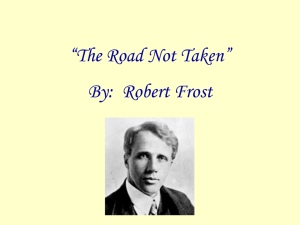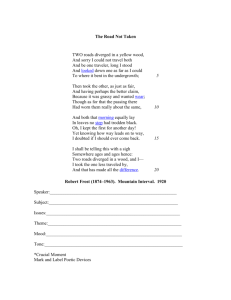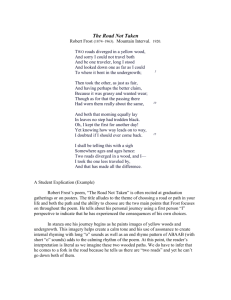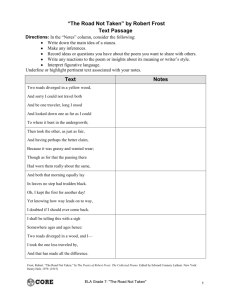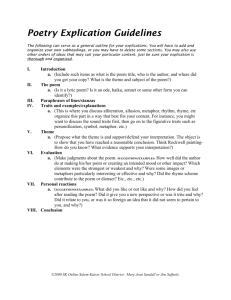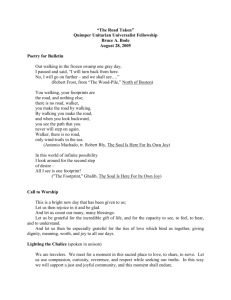Here is an example of an explication
advertisement
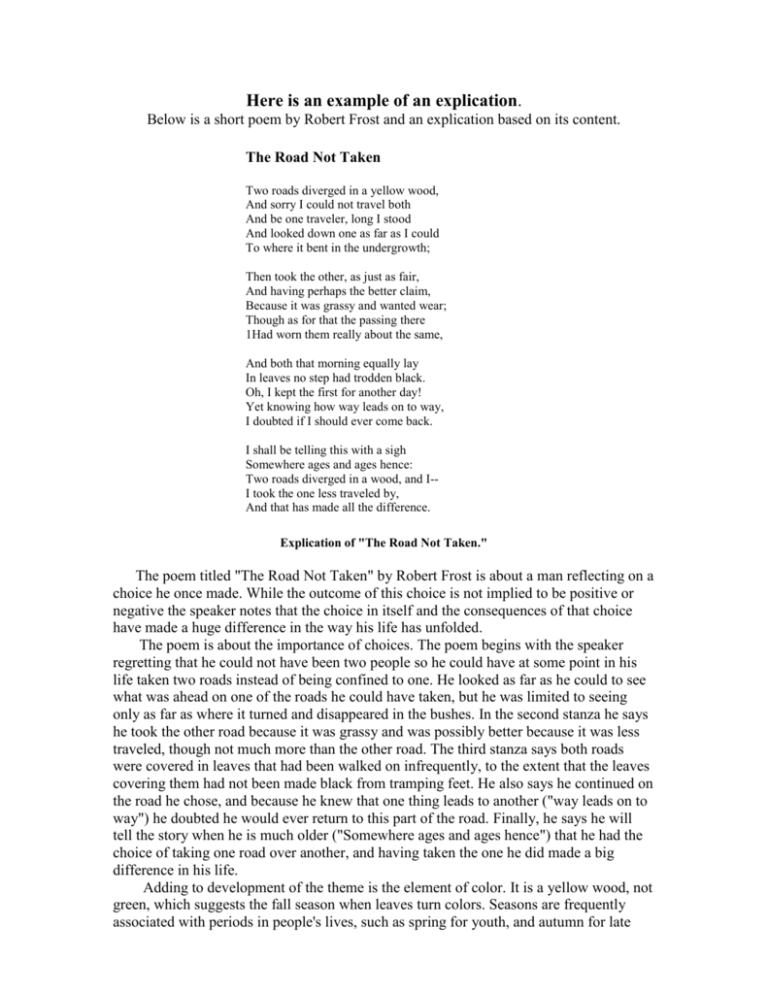
Here is an example of an explication. Below is a short poem by Robert Frost and an explication based on its content. The Road Not Taken Two roads diverged in a yellow wood, And sorry I could not travel both And be one traveler, long I stood And looked down one as far as I could To where it bent in the undergrowth; Then took the other, as just as fair, And having perhaps the better claim, Because it was grassy and wanted wear; Though as for that the passing there 1Had worn them really about the same, And both that morning equally lay In leaves no step had trodden black. Oh, I kept the first for another day! Yet knowing how way leads on to way, I doubted if I should ever come back. I shall be telling this with a sigh Somewhere ages and ages hence: Two roads diverged in a wood, and I-I took the one less traveled by, And that has made all the difference. Explication of "The Road Not Taken." The poem titled "The Road Not Taken" by Robert Frost is about a man reflecting on a choice he once made. While the outcome of this choice is not implied to be positive or negative the speaker notes that the choice in itself and the consequences of that choice have made a huge difference in the way his life has unfolded. The poem is about the importance of choices. The poem begins with the speaker regretting that he could not have been two people so he could have at some point in his life taken two roads instead of being confined to one. He looked as far as he could to see what was ahead on one of the roads he could have taken, but he was limited to seeing only as far as where it turned and disappeared in the bushes. In the second stanza he says he took the other road because it was grassy and was possibly better because it was less traveled, though not much more than the other road. The third stanza says both roads were covered in leaves that had been walked on infrequently, to the extent that the leaves covering them had not been made black from tramping feet. He also says he continued on the road he chose, and because he knew that one thing leads to another ("way leads on to way") he doubted he would ever return to this part of the road. Finally, he says he will tell the story when he is much older ("Somewhere ages and ages hence") that he had the choice of taking one road over another, and having taken the one he did made a big difference in his life. Adding to development of the theme is the element of color. It is a yellow wood, not green, which suggests the fall season when leaves turn colors. Seasons are frequently associated with periods in people's lives, such as spring for youth, and autumn for late middle age. So this is the "fall" of his life, or possibly around middle age. Therefore, he is a speaker who has had enough experiences to realize how important some decisions can be and that he must live with the consequences. The speaker also notes the leaves are not "trodden black" which would represent heavy traffic. However, the most crucial trait related to the theme is the metaphorical language where Frost compares roads to optional courses people can take in their lives. By the speaker regretting he could take only one "road," it means he does not have the chance to take several directions in life at one time to see how each will work out, since he cannot look ahead to see where each choice might lead ("undergrowth": or our inability to foretell the future), or where the next choices in each of those "roads" would also lead. He must choose one and see where it will lead and what other choices will follow on that road. One thing the speaker knows is the choice is not to be taken lightly because it could, as he realizes while he reflects, be the difference between two very different life experiences ("And that has made all the difference"). Frost's use of metaphor is effective in him presenting his theme. Even if readers did not know that "road" was being used metaphorically, they would still know the poem is about a man making a choice. Using the idea of roads is something we can relate to because we have probably all come to two roads, literally, and have been uncertain about which way to turn. Sometimes we have turned and found that it was the wrong way and that has cost us time, made us late, or lead us somewhere we did not want to go. We can see in some way how even relatively insignificant decisions alter our lives, at least a temporarily. "The Road Not Taken" is a pleasant and thought-inspiring poem. It is pleasant because Frost keeps the tone and mood light though it is about a very serious subject. Though it is subtly reminiscent, it still makes a strong point. Reading it can also make one think more consciously about future decisions and their potential consequences. Reading this poem was like taking a little side road. It can make a difference. Frost uses a common experience to which we can all relate -- making a choice at the junction of two roads -- in order to show that a decision will lead us in one direction, and making the choice to go in that direction can make a profound difference in our lives. Things to note in the sample explication: 1. It generally follows general organization rules. It includes an introduction and a conclusion. 2. The introduction includes the thesis statement. 3. Each paragraph has a topic sentence that expresses the main idea of the paragraph. 4. The conclusion summarizes the main points of the explication. 5. Transitions are used to show the relationship between ideas and help lead the reader smoothly from one idea to the next. 6. Each element is explained and lines or examples from the poem are given for clarification. 7. It demonstrates understanding beyond the obvious or literal. 8. It's detailed. Yours may not always be so long; it depends on the nature of the poem being used.
